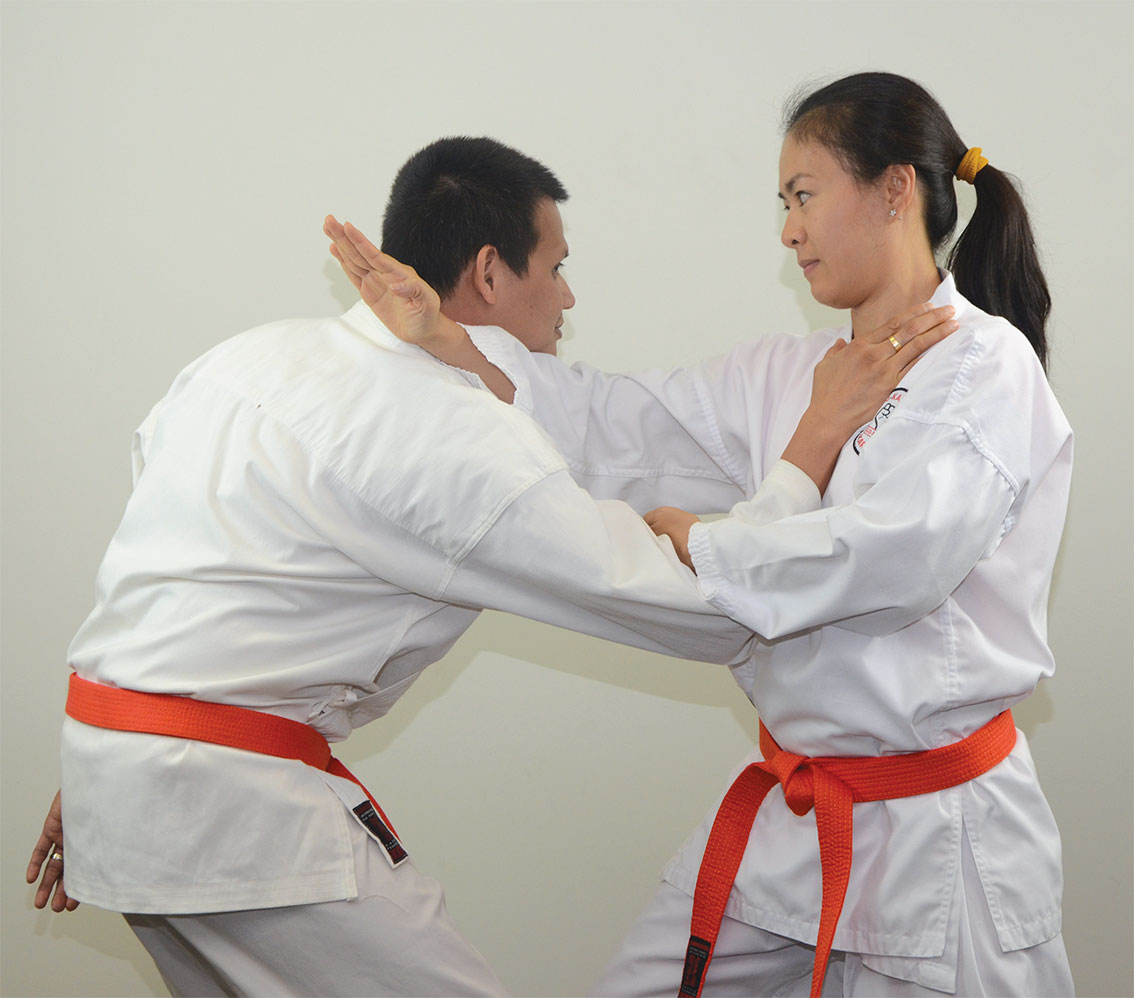Kumite: More than Sport
I hope this article speaks volumes to you and succeeds in opening your mind to something bigger than the dojo or tournaments. Regardless of our prowess in kumite, always keep in mind the first aim and purpose of karate is self-defence. This is an important mindset to adopt in your karate.
So for the moment, discard your concept of sparring and draw your attention to a hypothetical real-life confrontation. In most cases, it is the attacker who will initiate the first strike. With this in mind, it is the karate-ka who has taken the time to develop a sound defensive ability that would most likely walk away unharmed. They may not rule their dojo and may lack the prestigious tournament accolades, yet they succeeded when it mattered most.
Please do not mistake my intentions here. I am taking nothing away from those people who have worked hard and won tournaments. Nor am I suggesting that people should spend all their kumite time working on defence. You will have no argument from me that attacking is vital and getting in first is often a wise move – especially in situations involving multiple attackers. Ultimately that is a judgment call based on the situation at hand.
I deeply care about the well-being of all students and hope that all can grasp the concept that sparring is more than a sport. While it is to be enjoyed, it is imperative that sparring has a sense of realness behind it and that we aim to develop a balanced ability in attack and defence. However, this article was conceived through the observation that most students are far more apt in their attacking. I believe one reason for this is that people tend to gravitate towards those things they are good at and avoid those areas where they struggle. To start with, there is no substitute for practice. You may not be proficient in your defence but as long as you appreciate its relevance, you will commit to its practice.
By sharing some important points on defence, I hope to speed up your process of turning a weak defence into success. For many students, during kumite, their primary objective is to attack and get in first. This results in the development of solid, fluent attacking combinations. Perhaps they have the strongest kumite in their dojo or even go on to win a number of tournaments – fantastic! And, while their blocking and counter-striking abilities are often quite limited, they often disregard this weakness in their sparring…after-all, they are dominating in the dojo and in tournaments anyway. To add to this, there is that old cliché “The best defence is a strong offense”.
Stance Counts
Have you ever forbade yourself from moving backward and insisted to yourself that you will stand your ground and block – only to find yourself retreating each time?
Where this could be a number of reasons, it is often a symptom of a sparring stance too short and too high. Many people have a sparring stance that barely extends one shoulder width and virtually no bend in their knees. This results in a high center of gravity, a widely exposed target area and equally important, has absolutely no strength.
Your subconscious will be aware of this and in the face of an attack, will start to retreat backwards – despite your insistence to stand your ground.
Most good counter-attackers will hold a stance at least one shoulder-width long (or one and a half for taller people who have a higher center of gravity) and have their knees well bent. This creates strength and minimizes your opponent’s target area. You should feel quite strong and stable in your stance. You should feel you can move fast, but equally can be steadfast.
A way to practice this and develop confidence is to stand in sparring stance and have someone try to push you backward. You will, over time, develop the body balance and strength to hold your ground.
Angle Counts
Another reason people struggle with defence is that they stand too square (front-on) as opposed to standing on a 45 degree angle. This bad habit, often spawned by desire to facilitate an attacking reverse punch, requires correcting for two reasons. Firstly, while the attacking reverse punch may come out more easily, it will have less power than if it were to come from a 45 degree angle as the hips are not contributing to the punch’s power. However, for this topic, let us look at its adverse effects on our defence – both mentally and physically.
Most of the vital areas of the body are found down its middle (from the eyes, nose, jaw, throat, solar plexus, stomach and groin). It is inherent to human nature to be aware of these areas, and when faced with danger, our natural reaction in to turn away or go into a fetal position – two traits that detract from karate spirit and ability.
Physically it is far more difficult to protect an open (square) body than it is to protect one turned off. When our stance is on a 45 degree angle, there is less surface area to cover.
Guard Counts
Every person’s guard during kumite communicates. It either says, “stay away, there is no room for your techniques here” or it says “come on in because I won’t stop you”. What does your guard communicate?
When an opponent sees targets everywhere, they will have more confidence to attack – and with confidence comes competence. When an opponent cannot seem to find any holes or easily see any targets in your guard they will hesitate and attack with less conviction. Your guard is like your fortress and like any good fortress, it best keeps away attackers by its discouraging appearance.
- Stand on a 45 degree angle.
- Hold your front hand higher (around throat height) making it easier to protect your head or attack with a lunge punch.
- Hold your back hand lower (around solar plexus height) making it easier to both protect your body and launch a reverse punch.
- Keep your hands out from your body. This gives you more time to block, enables you to meet an attacking limb further out from your body (where it has less power) and gives your opponent less visible targets.
Reading Your Opponent
Another reason many have a lack lustre defence is due to the old adage that ‘action is faster than reaction’. Because this is very true, and most realize it in sparring, they opt to attack whenever possible. When it comes to sparring, the fatal flaw to this theory is that to the careful observer, the first action is rarely an attack. Actually, most people’s first action is to move into an attacking position before launching their onslaught. For example, a split second before punching they might bring their hand in towards their body, or lower their stance, or suck in a deep breath etc. This split second is the time required for you to react to their attack.
When sparring, become a careful observer to those you are sparring. Try to read their body language and look for signals that they are about to pounce.
The Open Fortress
Most people believe in sparring that the attacker has the advantage. Perhaps it stems from the previous point. However, once you have developed good reflexes and fluent blocks, it is actually the opposite. Think about it…there you both stand with a good guard, poised and ready to throw a powerful punch from your strong stance. Like a game of chess, you both analyse the situation and look for openings. Patience is paramount. One suddenly launches into a lunge punch. Now let’s freeze it there. Here we find one person waiting patiently with their guard (fortress) still in with its walls secure. Front hand ready to block and reverse hand ready to land a powerful blow. Now let’s examine our attacker mid- flight. To attack they must risk opening up their fortress. Their front hand is out (with a punch) but leaving the soft lower ribs vulnerable. What happens next? To the well-practiced defender, it presents an opportunity to deliver a punch to an open fortress. Their front hand defends the oncoming attack and they make the most of the opportunity presented.
Related Articles
Preparing For A Major Tournament
Returning To Karate Training After A Break




